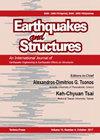橡胶支座MSCSS的总体优化、能量分析和地震反应研究
IF 1.4
4区 工程技术
Q3 ENGINEERING, CIVIL
引用次数: 6
摘要
巨型子控制结构系统(MSCSS)是一种创新的建筑结构振动被动控制系统,通过在下部结构顶部添加铅橡胶轴承(LRB)进行了改进。对于新系统,采用遗传算法对阻尼器和LRB的动态参数和分布进行了优化。该程序以各种抗震性能指标为优化目标,并对相应的结果进行了比较。研究发现,能量耗散率最大化的优化程序产生了最佳解,并且优化模型在不同地震下具有一致的抗震性能。在El Centro波、Taft波和其他20种人工波的作用下,对优化的MSCSS模型(有LRB和无LRB)和传统的Mega Sub Structure模型的抗震性能进行了评估和比较。在弹性和塑性分析中,具有LRB的模型显示出比其他两个模型明显更小的楼层漂移和水平加速度,并且在严重地震期间产生的塑性铰链更少。能量分析还表明,安装在适当位置的LRB增加了阻尼器的变形和能量耗散,从而显著降低了结构中的动能、势能和滞回能。但是,LRB不必安装在所有额外的立柱上。研究还表明,在不利位置的LRB可以降低阻尼器的能量耗散。LRB安装后,阻尼器的最佳阻尼系数和最佳阻尼指数都会降低,以产生最佳的阻尼效果。本文章由计算机程序翻译,如有差异,请以英文原文为准。
Generic optimization, energy analysis, and seismic response study for MSCSS with rubber bearings
The Mega-Sub Controlled Structure System (MSCSS), an innovative vibration passive control system for building structures, is improved by adding lead rubber bearings (LRBs) on top of the substructure. For the new system, a genetic algorithm is used to optimize the dynamic parameters and distributions of dampers and LRBs. The program uses various seismic performance indicators as optimization objectives, and corresponding results are compared. It is found that the optimization procedure for maximizing the energy dissipation ratio yields the best solutions, and optimized models have consistent seismic performances under different earthquakes. Seismic performances of optimized MSCSS models with and without LRBs, as well as the traditional Mega-Sub Structure model, are evaluated and compared under El Centro wave, Taft wave and 20 other artificial waves. In both elastic and plastic analysis, the model with LRBs shows significantly smaller story drift and horizontal acceleration than those of the other two models, and fewer plastic hinges are developed during severe earthquakes. Energy analysis also shows that LRBs installed in proper locations increase the deformation and energy dissipation of dampers, thereby significantly reduce the kinetic, potential, and hysteretic energy in the structure. However, LRBs do not have to be mounted on all the additional columns. It is also demonstrated that LRBs at unfavorable locations can decrease the energy dissipation for dampers. After LRBs are installed, the optimal damping coefficient and the optimal damping exponent of dampers are reduced to produce the best damping effect.
求助全文
通过发布文献求助,成功后即可免费获取论文全文。
去求助
来源期刊

Earthquakes and Structures
ENGINEERING, CIVIL-ENGINEERING, GEOLOGICAL
CiteScore
2.90
自引率
20.00%
发文量
0
审稿时长
>12 weeks
期刊介绍:
The Earthquakes and Structures, An International Journal, focuses on the effects of earthquakes on civil engineering structures. The journal will serve as a powerful repository of technical information and will provide a highimpact publication platform for the global community of researchers in the traditional, as well as emerging, subdisciplines of the broader earthquake engineering field. Specifically, some of the major topics covered by the Journal include: .. characterization of strong ground motions, .. quantification of earthquake demand and structural capacity, .. design of earthquake resistant structures and foundations, .. experimental and computational methods, .. seismic regulations and building codes, .. seismic hazard assessment, .. seismic risk mitigation, .. site effects and soil-structure interaction, .. assessment, repair and strengthening of existing structures, including historic structures and monuments, and .. emerging technologies including passive control technologies, structural monitoring systems, and cyberinfrastructure tools for seismic data management, experimental applications, early warning and response
 求助内容:
求助内容: 应助结果提醒方式:
应助结果提醒方式:


